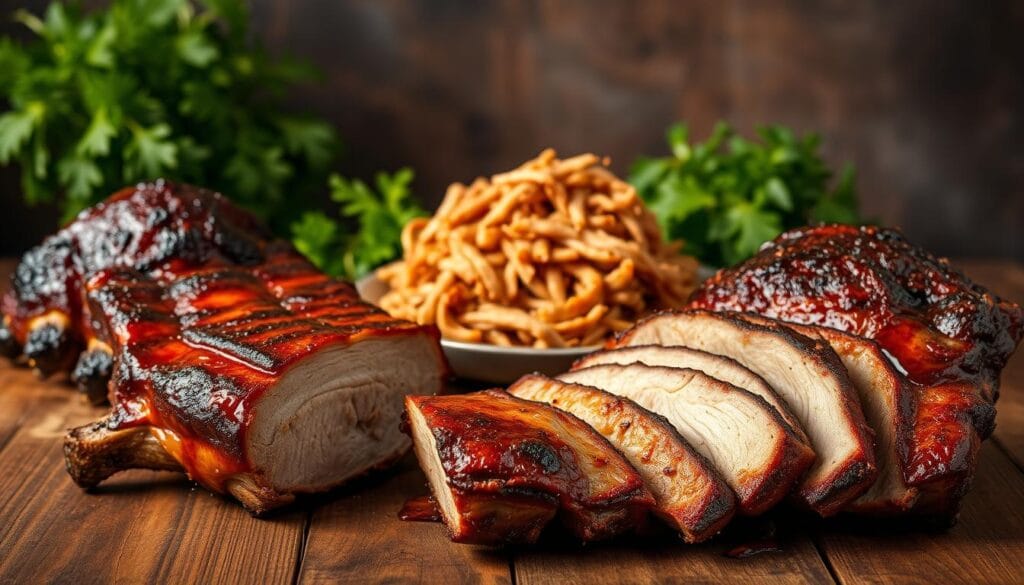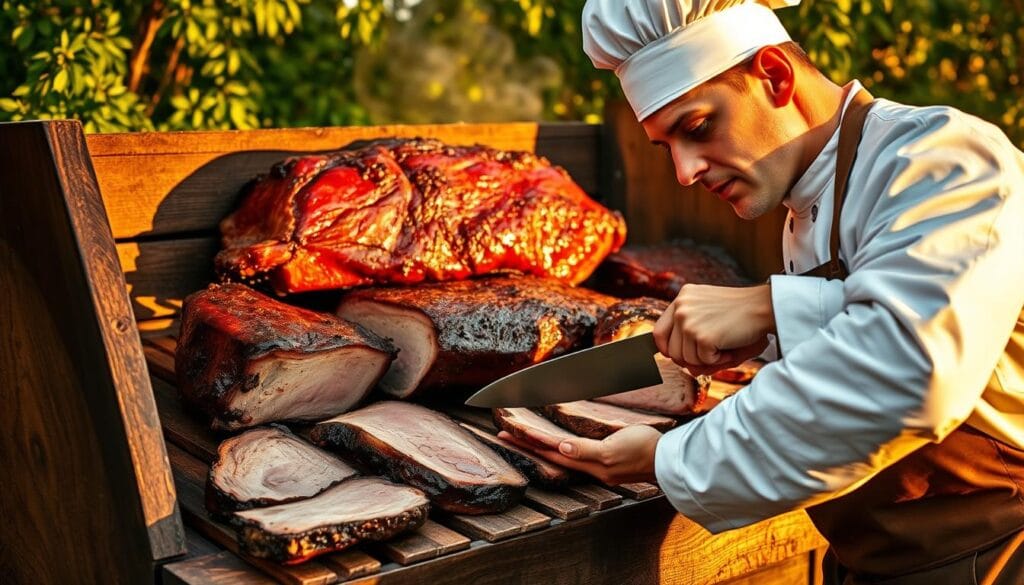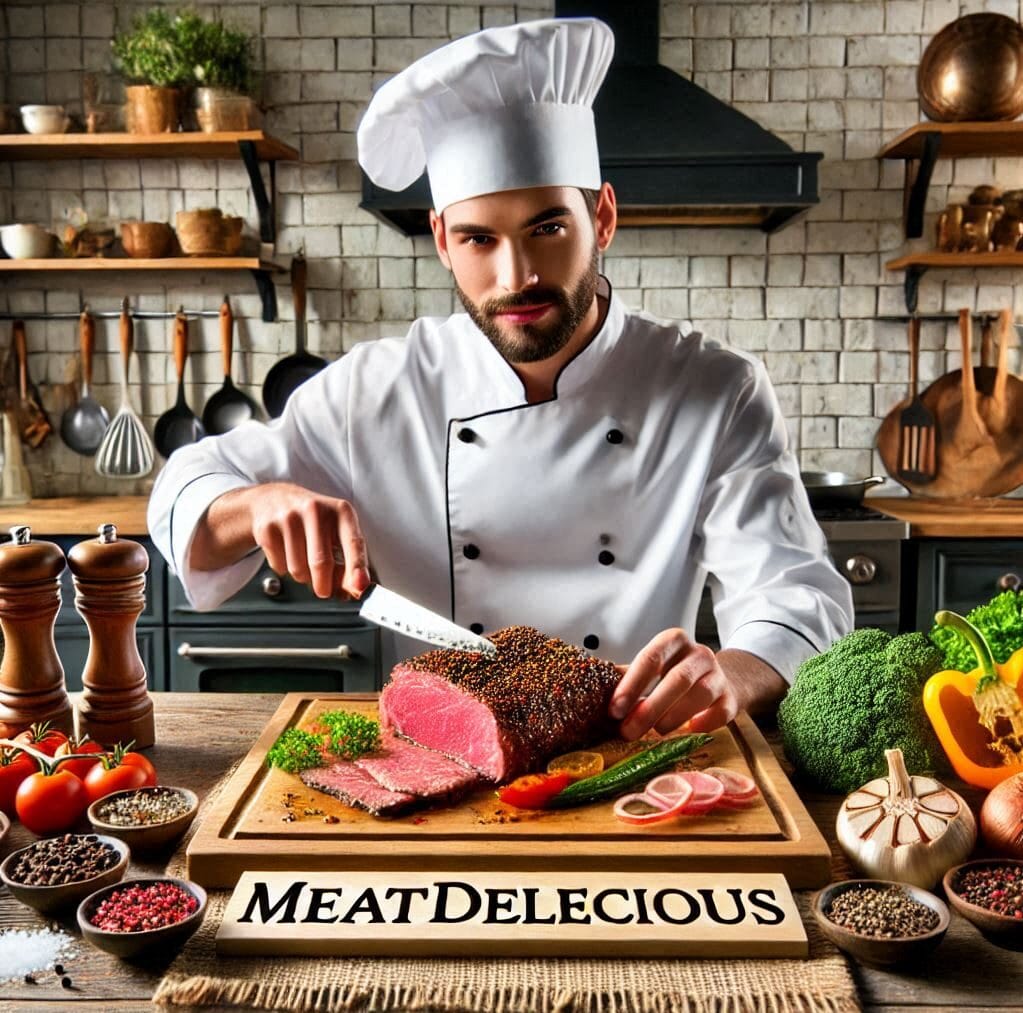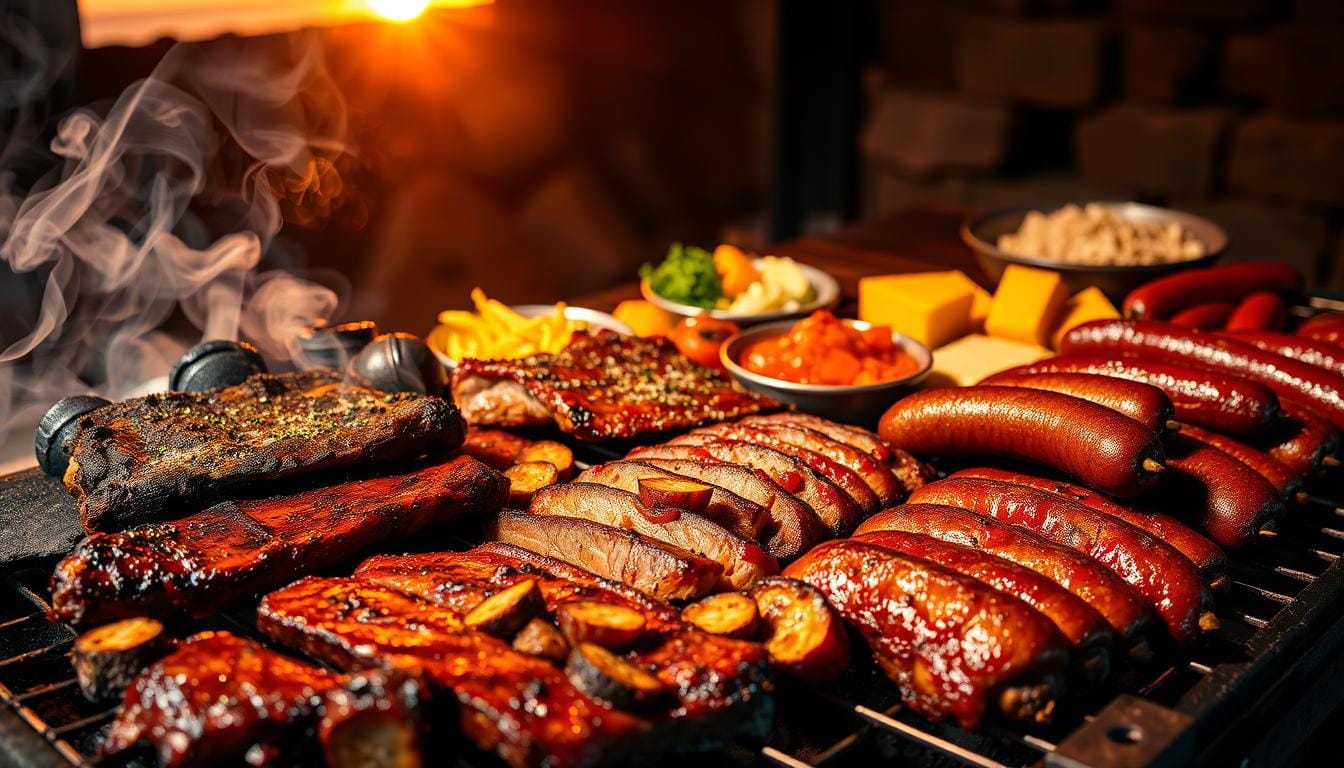Mouth-Watering Smoked Meat Recipes to Try Today
Dive into the world of BBQ smoked meats, where flavor meets culinary expertise. Smoking meat isn’t just cooking—it’s an art form. It transforms ordinary cuts into extraordinary dishes packed with rich, smoky goodness.
Your journey into smoked meat recipes starts with understanding the basics. From tender brisket to succulent pork shoulder, smoking creates depth of flavor. Grilling simply can’t match it. Professional pitmasters know the secret: low and slow cooking brings out remarkable taste and tenderness.
Whether you’re a backyard BBQ enthusiast or a serious meat lover, these smoked meat recipes will elevate your cooking game. We’ll explore techniques that turn simple ingredients into mouthwatering masterpieces. These will impress family and friends.
Key Takeaways
- Smoking meat requires patience and precise temperature control
- Different meats need unique smoking approaches
- Quality ingredients are crucial for exceptional BBQ smoked meats
- Wood selection dramatically impacts overall flavor profile
- Practice makes perfect in mastering smoking techniques
Essential Equipment for Smoking Meat
Starting with homemade smoked meats needs the right tools and knowledge. Whether you’re new or have experience, the right equipment makes a big difference. It can turn your smoked meat ideas into something amazing.
Types of Smokers and Their Benefits
Choosing the right smoker is key for tasty smoked meats. Each type has its own benefits:
- Pellet Smokers: Easy to use with consistent temperature control
- Charcoal Smokers: Provide traditional smoky flavor
- Electric Smokers: Convenient for indoor and outdoor use
- Kamado-Style Grills: Excellent heat retention and versatility
Must-Have Smoking Tools and Accessories
Improve your smoking with these essential tools:
| Tool | Purpose |
|---|---|
| Meat Thermometer | Ensure perfect cooking temperatures |
| Long-Handled Tongs | Safe meat handling |
| Silicone BBQ Brush | Evenly apply sauces |
| Heat-Resistant Gloves | Protection from high temperatures |
| Meat Claws | Shredding and handling large cuts |
Temperature Control Devices
Controlling temperature is critical for smoking success. Remote BBQ thermometers with multiple probes let you watch both smoker heat and meat temperature. This tech keeps your cooking steady for perfect homemade smoked meats.
Pro tip: Always have a spray bottle ready. It keeps meat moist and helps smoke stick better during smoking.
Understanding Different Wood Types for Smoking
Choosing the right wood is key to making great smoked meat. Each wood type adds a special flavor that can change your BBQ game. Knowing these differences can improve your smoking skills.
Wood choice is vital for the perfect smoky taste. Certain meats go well with specific woods, making a mix of flavors that wow BBQ fans.
Recommended Wood Types by Meat
- Beef: Oak, hickory, and mesquite are top picks
- Pork: Apple, cherry, and hickory are great choices
- Poultry: Apple, cherry, and peach are best for poultry
- Fish: Alder and fruit woods are perfect for fish
Experts say knowing wood intensity is important. Light woods like apple give sweet, mild flavors for tender meats. Medium woods, like oak, offer balanced smokiness. Heavy woods, like hickory, add strong, bold tastes for red meats.
Wood Size and Smoking Techniques
- Wood chunks: Best for long, slow cooking
- Wood chips: Ideal for quick smoking sessions
- Wood pellets: Great for keeping a steady temperature
Tip for the best smoked meat: Mix wood types for complex flavors. Start with milder woods and experiment to find your unique smoke blend.
Basic Smoking Techniques and Tips
Learning to smoke meat is an art that needs a few key techniques. These tips will help you make delicious smoked meat recipes. They will impress your friends and family.
Proper Temperature Management
Keeping the right temperature is key to smoking success. Aim for 225°F to 250°F. Once you add meat, the temperature will drop to 220°F, ideal for slow cooking. Always use a meat thermometer to check both the smoker and the meat’s temperature.
- Maintain consistent heat between 225°F-250°F
- Use a water pan to stabilize temperature
- Check temperatures regularly
Achieving the Perfect Smoke Ring
A beautiful smoke ring is a sign of well-smoked meat. To get this, focus on the smoke quality. Aim for thin, blue smoke for better flavor and to avoid bitterness.
Resting and Slicing Techniques
After smoking, letting the meat rest is crucial. For big cuts like brisket, rest for up to 45 minutes. This makes the meat juicy and tender.
- Remove meat from smoker
- Wrap in butcher paper or aluminum foil
- Let rest for 30-45 minutes
- Slice against the grain
Pro tip: Always slice meat against the grain to ensure the most tender and enjoyable eating experience.
Best Smoked Meat Recipes for Beginners
Starting with smoked meat recipes can feel daunting. But, some cuts are great for beginners. They help you grow your skills and confidence with each try.
For newbies, some meats are easier to work with. Smoked pulled pork is a top pick. It’s forgiving and affordable.
- Pulled Pork: Easy to smoke and incredibly flavorful
- Chicken: Versatile and quick to prepare
- Pork Ribs: Using the 3-2-1 method for tender results
- Lamb Shoulder: Adaptable to various flavor profiles
The 3-2-1 method for ribs is great for beginners. It ensures meat that’s tender and falls off the bone. Even seasoned BBQ fans will be impressed.
Learning to spatchcock chicken is key for beginners. It makes the bird flat, so rubs and flavors penetrate better. This method is perfect for both chicken and turkey, making the skin crispy and flavorful.
Begin with meats that are forgiving. Pork belly burnt ends are easier than brisket. They offer a moist inside and crunchy outside, boosting your confidence.
Pro tip: Keep your smoker at 225°F to 275°F for the best results in most beginner recipes.
Remember, the more you practice, the better you’ll get. Each time you smoke, you’ll learn more. You’ll get better at using your equipment and making delicious dishes.
Classic Smoked Brisket Preparation
Smoking a perfect brisket is an art that needs patience, skill, and detail. Your journey to making delicious homemade smoked meats begins with picking the right cut. Then, you master key preparation techniques.
Selecting Your Brisket
Choose a high-quality brisket with good marbling. USDA Prime brisket tastes the best, but Choice grade is also great. A whole packer brisket weighs 12-14 pounds. It has two muscles: the lean flat cut and the fatty point cut.
Trimming and Seasoning Techniques
Trimming is key for a great smoked brisket. Leave about ¼ inch of fat cap for moisture and flavor. For seasoning, make a dry rub with:
- ¼ cup table salt
- 1½ tablespoons ground black pepper
- 1½ tablespoons smoked paprika
- 2 teaspoons cayenne pepper
- Garlic and onion powder
Smoking Process Timeline
| Stage | Temperature | Duration |
|---|---|---|
| Initial Smoking | 225°F | 6-8 hours |
| Wrapping | Internal temp 165°F | 4-5 hours |
| Final Cooking | 203°F | 1-2 hours |
Wrapping and Resting
Wrapping your brisket in butcher paper keeps it moist and cooks faster. After reaching the target internal temperature, rest the brisket in an insulated cooler for 1-3 hours. This step relaxes muscle fibers and redistributes juices, making it tender and flavorful.
“Patience is the secret ingredient in creating the perfect BBQ smoked meats.” – Pitmaster Wisdom
Delicious Smoked Pork Variations

Pork is a great meat for smoking, offering amazing flavor and versatility. Whether you’re new or experienced, trying different pork cuts can make your dishes better.
Several pork cuts are excellent for smoking:
- Pork Shoulder (Boston Butt)
- Pork Ribs
- Pork Tenderloin
- Pork Loin Roast
The pork butt is great for beginners. It’s about 2.5 lbs, giving you a chance to practice. Smoking times vary based on the cut and size:
| Pork Cut | Weight | Smoking Time | Target Temp |
|---|---|---|---|
| Pork Loin Roast | 2-3 lbs | 1.5-2 hours | 145°F |
| Pork Shoulder | 4-5 lbs | 3+ hours | 195°F |
“The secret to great smoked pork is patience and low, consistent temperature.” – BBQ Experts
Pro tip: Always let your pork rest for 30 minutes before smoking. Let it rest again after cooking. This keeps it moist and flavorful. Your smoked pork can last up to 5 days in the fridge or 6 months in the freezer.
Poultry Smoking Masterclass
Smoking chicken and turkey turns them into tasty dishes that wow everyone. It’s a skill that can be learned by anyone, from beginners to seasoned pitmasters.
To smoke poultry well, you need to know a few key steps. These steps help take your smoked meat recipes from great to amazing. The main things to focus on are temperature, moisture, and how to prepare the meat.
Whole Chicken Smoking Essentials
For smoking a whole chicken, keep the temperature between 300-350°F. This ensures the skin gets crispy and the meat stays juicy. Here are some important tips to follow:
- Pat the chicken dry before seasoning
- Use a meat thermometer to check internal temperature
- Achieve an internal temperature of 165°F for safety
Wing and Thigh Preparation Techniques
Smaller chicken parts like wings and thighs need a different approach. Marinating or brining helps keep them moist and adds flavor.
Brining: The Secret to Moist Poultry
Brining is a key technique for smoking poultry. A simple saltwater brine can make the meat tender and flavorful. Here’s how to make a basic brine:
- 4 cups water
- 1/4 cup kosher salt
- Optional herbs and spices
Pro tip: Brine your chicken for 4-6 hours before smoking for maximum flavor and moisture.
Smoking poultry requires patience and careful attention. With time and practice, you’ll make delicious smoked chicken that everyone will love.
Advanced Smoked Meat Recipes

Are you ready to take your smoked meat recipes to the next level? Advanced BBQ smoked meats need precision, creativity, and a bold spirit to try new things. This means exploring unique cuts and techniques.
For those who have mastered the basics, trying new meats can really boost your BBQ skills. Beef cheeks, for example, are perfect for slow cooking. They turn out tender and full of flavor.
- Unique meat cuts to explore:
- Beef cheeks
- Duck breast
- Lamb shoulder
- Venison
Temperature control is key when making these advanced dishes. For instance, smoking a brisket needs a steady 225°F. You also need to watch the internal temperature until it hits 203°F for the best tenderness.
Pro tip: Patience is the secret ingredient in advanced smoking techniques.
When making smoked meat recipes, think about these advanced techniques:
- Try out complex dry rubs
- Learn how to smoke in stages
- Find ways to keep meat moist
- Choose the right wood for flavor
By advancing your BBQ skills, you’ll make dishes that wow even the toughest critics. Your BBQ will be on par with the best restaurants.
Creating Perfect Smoke Rings and Bark
Exploring homemade smoked meats means learning about smoke rings and bark. Smoke rings form when myoglobin and carbon monoxide react, usually between 225°F and 250°F. Different woods can make these rings more intense, with drier meats showing more smoke.
Creating great bark is all about the Maillard reaction. This happens when sugars and proteins meet high heat. Brisket, for example, gets a better bark because it cooks longer. Adding brown sugar, mustard, and paprika can make the bark even tastier.
To get the perfect bark, control moisture and temperature well. The bark should be crisp and not dry or leathery. Pitmasters watch the bark’s color and adjust the temperature to avoid burning. Wrapping meat in butcher paper later helps keep it moist and crisp.
Even though a smoke ring looks cool, it doesn’t always mean the meat tastes better. What’s more important is tender, juicy meat with great bark. By mastering these techniques, your smoked meats will go from good to amazing.

